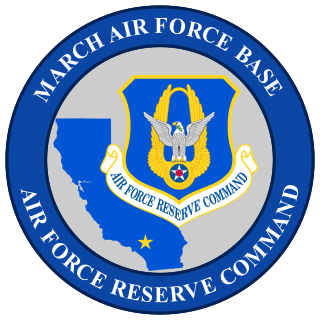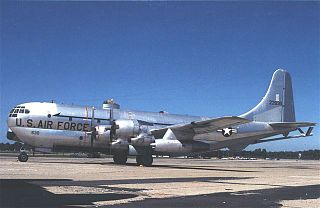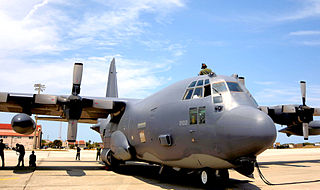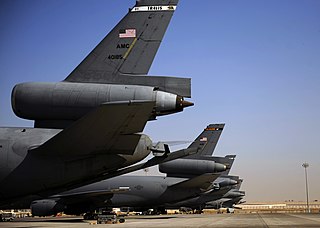
March Air Reserve Base, previously known as March Air Force Base, is located in Riverside County, California, between the cities of Riverside, Moreno Valley, and Perris. It is the home to the Air Force Reserve Command's Fourth Air Force Headquarters and the host of the 452nd Air Mobility Wing, the largest air mobility wing of the Fourth Air Force. In addition to multiple units of the Air Force Reserve Command supporting Air Mobility Command, Air Combat Command and Pacific Air Forces, March ARB is also home to units from the Army Reserve, Navy Reserve, Marine Corps Reserve, California Air National Guard and the California Army National Guard. For almost 50 years, March AFB was a Strategic Air Command base during the Cold War. The facility covers 2,075 acres of land.

Scott Air Force Base is a United States Air Force base in St. Clair County, Illinois, near Belleville and O'Fallon, 17 miles (27 km) east-southeast of downtown St. Louis. Scott Field was one of 32 Air Service training camps established after the United States entered World War I in April 1917. It is headquarters of Air Mobility Command (AMC) and its showcase wing, and it is also the headquarters of the U.S. Transportation Command, a Unified Combatant Command that coordinates transportation across all the services.

Wilbur Wright Field was a military installation and an airfield used as a World War I pilot, mechanic, and armorer training facility and, under different designations, conducted United States Army Air Corps and Air Forces flight testing. Located near Riverside, Ohio, the site is officially "Area B" of Wright-Patterson Air Force Base and includes the National Museum of the United States Air Force built on the airfield.

Roosevelt Field is a former airport, located in Westbury, Long Island, New York. Originally called the Hempstead Plains Aerodrome, or sometimes Hempstead Plains field or the Garden City Aerodrome, it was a training field for the Air Service, United States Army during World War I.

Mather Air Force Base was a United States Air Force Base, which was closed in 1993 pursuant to a post-Cold War BRAC decision. It was located 12 miles (19 km) east of Sacramento, on the south side of U.S. Route 50 in Sacramento County, California. Mather Field was one of 32 Air Service training camps established after the United States entry into World War I in April 1917.

The Boeing KC-97 Stratofreighter is a four-engined, piston-powered United States strategic tanker aircraft based on the Boeing C-97 Stratofreighter. It replaced the KB-29 and was succeeded by the Boeing KC-135 Stratotanker.

Rockwell Field is a former United States Army Air Corps (USAAC) military airfield, located 1.1 miles northwest of the city of Coronado, California, on the northern part of the Coronado Peninsula across the bay from San Diego, California.

The 1st Reconnaissance Squadron is a United States Air Force squadron, assigned to the 9th Operations Group, Beale Air Force Base, California.

The Ohio Air National Guard is the aerial militia of the State of Ohio, United States of America. It is a reserve of the United States Air Force and along with the Ohio Army National Guard an element of the Ohio National Guard of the larger United States National Guard Bureau.

Ellington Field Joint Reserve Base is a joint installation shared by various active component and reserve component military units, as well as aircraft flight operations of the National Aeronautics and Space Administration (NASA) under the aegis of the nearby Johnson Space Center. The host wing for the installation is the Texas Air National Guard's 147th Attack Wing. Opened in 1917, Ellington Field was one of thirty-two Air Service training camps established after the United States entry into World War I. It is named for First Lieutenant Eric Ellington, a U.S. Army aviator who was killed in a plane crash in San Diego, California in 1913.

The 102nd Rescue Squadron is a unit of the New York Air National Guard 106th Rescue Wing stationed at Francis S. Gabreski Air National Guard Base, Westhampton Beach, New York. The 102nd is equipped with the HC-130J Combat King II transport aircraft.

The 106th Air Refueling Squadron is a unit of the Alabama Air National Guard 117th Air Refueling Wing. It is assigned to Birmingham Air National Guard Base, Alabama and is equipped with the KC-135R Stratotanker aircraft.

The 108th Air Refueling Squadron is a unit of the Illinois Air National Guard 126th Air Refueling Wing located at Scott Air Force Base, Belleville, Illinois. The 108th is equipped with the KC-135R Stratotanker.

The 116th Air Refueling Squadron is a unit of the Washington Air National Guard 141st Air Refueling Wing located at Fairchild Air Force Base, Spokane, Washington. The 116th was equipped with variants of the Boeing KC-135 Stratotanker from 1976 until 2007, at which time these aircraft were re-assigned to other units as a result of BRAC 2005.

The 110th Bomb Squadron is a unit of the Missouri Air National Guard 131st Bomb Wing located at Whiteman Air Force Base, Knob Noster, Missouri. The 110th is equipped with the Northrop Grumman B-2 Spirit.

The 2nd Air Refueling Squadron, sometimes written as 2d Air Refueling Squadron, is a unit of the United States Air Force. It is part of the 305th Air Mobility Wing at McGuire Air Force Base, part of Joint Base McGuire-Dix-Lakehurst, New Jersey. The 2nd Air Refueling Squadron is the second-oldest squadron in the Air Force, having over 100 years of service to the nation. It was deployed to the Philippines after World War I, during the 1941-1942 Battle of the Philippines, it was wiped out, with the Japanese forcing some of the personnel to endure the Bataan Death March. It was re-formed as an air refueling squadron by Strategic Air Command in 1949. Today, it operates the KC-46 Pegasus aircraft, conducting aerial refueling missions.

The 911th Air Refueling Squadron is part of the 305th Operations Group, and is stationed at Seymour Johnson Air Force Base, North Carolina. The squadron was the Air Force's first active duty squadron under the command of a reserve wing. In October 2016, the 911th, formerly geographically separated from the 6th Air Mobility Wing at MacDill Air Force Base, Florida and operated as the active duty associate to the 916th Air Refueling Wing, became the first "I-Wing" or Integrated Wing. In July 2020, it was reassigned to the 305th Operations Group at the McGuire AFB entity of Joint Base McGuire–Dix–Lakehurst, New Jersey.

The 48th Flying Training Squadron is part of the 14th Flying Training Wing based at Columbus Air Force Base, Mississippi. It operates T-1 Jayhawk aircraft conducting flight training. The squadron is one of the oldest in the Air Force, being formed during World War I as the 48th Aero Squadron on 4 August 1917.

Souther Field is a former military airfield, located 3.7 miles (6.0 km) Northeast of Americus, Georgia. It was one of thirty-two Air Service training camps established after the United States entry into World War I in April 1917.

The 908th Expeditionary Air Refueling Squadron is a provisional United States Air Force (USAF) unit. It is assigned to the 378th Air Expeditionary Wing at Prince Sultan Air Base in Saudi Arabia. It has supported combat operations in the War in Afghanistan (2001–2021), Iraq, and Syria from its previous location of Al Dhafra Air Base in the United Arab Emirates. The squadron has a varied background, having been formed by a series of consolidations of no fewer than five distinct units.





















